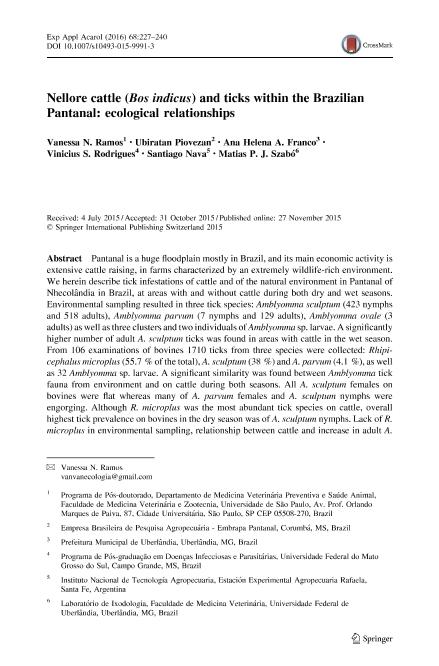Mostrar el registro sencillo del ítem
dc.contributor.author
Ramos, Vanessa N.
dc.contributor.author
Piovezan, Ubiratan
dc.contributor.author
Franco, Ana Helena A.
dc.contributor.author
Rodrigues, Vinicius S.
dc.contributor.author
Nava, Santiago

dc.contributor.author
Szabó, Matias P. J.
dc.date.available
2018-08-17T16:43:31Z
dc.date.issued
2016-02
dc.identifier.citation
Ramos, Vanessa N.; Piovezan, Ubiratan; Franco, Ana Helena A.; Rodrigues, Vinicius S.; Nava, Santiago; et al.; Nellore cattle (Bos indicus) and ticks within the Brazilian Pantanal: ecological relationships; Springer; Experimental and Applied Acarology; 68; 2; 2-2016; 227-240
dc.identifier.issn
0168-8162
dc.identifier.uri
http://hdl.handle.net/11336/56168
dc.description.abstract
Pantanal is a huge floodplain mostly in Brazil, and its main economic activity is extensive cattle raising, in farms characterized by an extremely wildlife-rich environment. We herein describe tick infestations of cattle and of the natural environment in Pantanal of Nhecolândia in Brazil, at areas with and without cattle during both dry and wet seasons. Environmental sampling resulted in three tick species: Amblyomma sculptum (423 nymphs and 518 adults), Amblyomma parvum (7 nymphs and 129 adults), Amblyomma ovale (3 adults) as well as three clusters and two individuals of Amblyomma sp. larvae. A significantly higher number of adult A. sculptum ticks was found in areas with cattle in the wet season. From 106 examinations of bovines 1710 ticks from three species were collected: Rhipicephalus microplus (55.7 % of the total), A. sculptum (38 %) and A. parvum (4.1 %), as well as 32 Amblyomma sp. larvae. A significant similarity was found between Amblyomma tick fauna from environment and on cattle during both seasons. All A. sculptum females on bovines were flat whereas many of A. parvum females and A. sculptum nymphs were engorging. Although R. microplus was the most abundant tick species on cattle, overall highest tick prevalence on bovines in the dry season was of A. sculptum nymphs. Lack of R. microplus in environmental sampling, relationship between cattle and increase in adult A. sculptum numbers in the environment as well as suitability of bovine for the various tick species are discussed.
dc.format
application/pdf
dc.language.iso
eng
dc.publisher
Springer

dc.rights
info:eu-repo/semantics/openAccess
dc.rights.uri
https://creativecommons.org/licenses/by-nc-sa/2.5/ar/
dc.subject
Amblyomma Parvum
dc.subject
Amblyomma Sculptum
dc.subject
Bovines
dc.subject
Brazil
dc.subject
Ecology
dc.subject
Rhipicephalus Microplus
dc.subject.classification
Otras Ciencias Biológicas

dc.subject.classification
Ciencias Biológicas

dc.subject.classification
CIENCIAS NATURALES Y EXACTAS

dc.title
Nellore cattle (Bos indicus) and ticks within the Brazilian Pantanal: ecological relationships
dc.type
info:eu-repo/semantics/article
dc.type
info:ar-repo/semantics/artículo
dc.type
info:eu-repo/semantics/publishedVersion
dc.date.updated
2018-08-16T17:37:49Z
dc.journal.volume
68
dc.journal.number
2
dc.journal.pagination
227-240
dc.journal.pais
Alemania

dc.journal.ciudad
Berlin
dc.description.fil
Fil: Ramos, Vanessa N.. Universidade de Sao Paulo; Brasil
dc.description.fil
Fil: Piovezan, Ubiratan. Embrapa Pantanal; Brasil
dc.description.fil
Fil: Franco, Ana Helena A.. Prefeitura Municipal de Uberlândia; Brasil
dc.description.fil
Fil: Rodrigues, Vinicius S.. Universidade Federal do Mato Grosso do Sul; Brasil
dc.description.fil
Fil: Nava, Santiago. Consejo Nacional de Investigaciones Científicas y Técnicas; Argentina. Instituto Nacional de Tecnología Agropecuaria. Centro Regional Santa Fe. Estación Experimental Agropecuaria Rafaela; Argentina
dc.description.fil
Fil: Szabó, Matias P. J.. Universidade Federal de Uberlândia; Brasil
dc.journal.title
Experimental and Applied Acarology

dc.relation.alternativeid
info:eu-repo/semantics/altIdentifier/doi/https://dx.doi.org/10.1007/s10493-015-9991-3
dc.relation.alternativeid
info:eu-repo/semantics/altIdentifier/url/https://link.springer.com/article/10.1007%2Fs10493-015-9991-3
Archivos asociados
